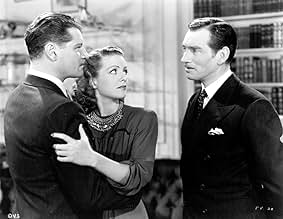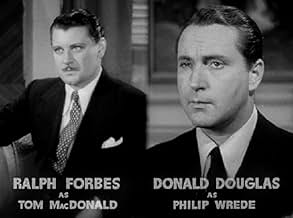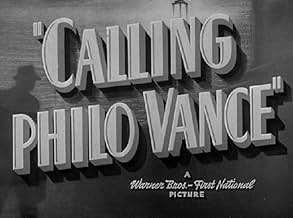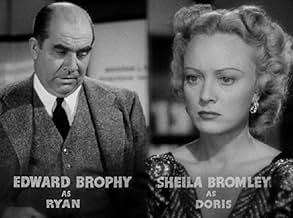Despite an exclusive contract with the U.S. government, designer Archer Coe's design is being bid on by German, Japanese, and Italian agents - until he's murdered.Despite an exclusive contract with the U.S. government, designer Archer Coe's design is being bid on by German, Japanese, and Italian agents - until he's murdered.Despite an exclusive contract with the U.S. government, designer Archer Coe's design is being bid on by German, Japanese, and Italian agents - until he's murdered.
- Director
- Writers
- Stars
Jimmy Conlin
- Dr. Doremus - Coroner
- (as Jimmy Conlon)
Wedgwood Nowell
- Brisbane Coe
- (as Wedgewood Nowell)
Herbert Anderson
- First Reporter
- (uncredited)
Henry Blair
- Hans Snauble
- (uncredited)
Egon Brecher
- Austrian Judge
- (uncredited)
- Director
- Writers
- All cast & crew
- Production, box office & more at IMDbPro
Featured reviews
One of the weakest Philo Vance films: a pointless remake of "The Kennel Murder Case", with a blander cast. But if you haven't seen "Kennel", you may still find the story ingenious. The then-topical WWII elements look out of place now in a Philo Vance mystery. ** out of 4.
While I do like JAMES STEPHENSON as an actor (he was excellent in THE LETTER with Bette Davis), he lacks the sort of debonair charm needed for the role of Philo Vance in CALLING PHILO VANCE. However, that's not integral to your enjoyment of this updating of "The Kennel Murder Case" which was made in '40 when the Nazis were making big strides during World War II.
Secret stolen plans for a bomber falling into the hands of German agents is the crux of the matter here, to the tune of $250,000. The story begins with Vance accepting an assignment in Vienna where he is trying to find out whether Archer Coe is selling aircraft plans to a foreign country. But the main story begins when he's deported to the U.S., escapes authorities and returns to investigate the case for Chief Investigator Markham (HENRY O'NEILL).
The wealthy household where Coe died in a locked room, is at first ruled as the scene of a suicide but soon evidence proves it to be a murder and there are several suspects--among them, RALPH FORBES, DONALD DOUGLAS and MARTIN KOSLECK, in an unusual role as a butler. Kosleck usually played German spies in all the Warner war films.
Under Stanely Clements' direction, the tale moves quickly to an all too abrupt conclusion with very little explanation given for the intricate murder plot. While not exactly plausible, it does make an interesting mystery for who-dun-it fans with some clever touches in the script.
But the main disappointment lies in not having a satisfactory actor in the Philo Vance role.
Secret stolen plans for a bomber falling into the hands of German agents is the crux of the matter here, to the tune of $250,000. The story begins with Vance accepting an assignment in Vienna where he is trying to find out whether Archer Coe is selling aircraft plans to a foreign country. But the main story begins when he's deported to the U.S., escapes authorities and returns to investigate the case for Chief Investigator Markham (HENRY O'NEILL).
The wealthy household where Coe died in a locked room, is at first ruled as the scene of a suicide but soon evidence proves it to be a murder and there are several suspects--among them, RALPH FORBES, DONALD DOUGLAS and MARTIN KOSLECK, in an unusual role as a butler. Kosleck usually played German spies in all the Warner war films.
Under Stanely Clements' direction, the tale moves quickly to an all too abrupt conclusion with very little explanation given for the intricate murder plot. While not exactly plausible, it does make an interesting mystery for who-dun-it fans with some clever touches in the script.
But the main disappointment lies in not having a satisfactory actor in the Philo Vance role.
This is an adequate afternoon B-feature that probably served more as a warning against fifth-columnists than it actually entertained anyone. It all centres around attempts by the Axis powers to obtain access to the designs of "Archer Coe" (the briefest of appearances from Richard Kipling). Now he has an exclusive arrangement with the Americans so when he is found murdered, it falls to the wily, suspicions and tenacious "Vance" (James Stephenson) to find out who the killers were and on whose malevolent behalf they were working? Did they manage to steal his secret plans? Now this is just a substantial reworking of "The Kennel Murder Case" (1933) - even down to whopping great chunks of the script being transferred, albeit updated, to allow for it's WWII scenario. Although all pretty lightweight and devoid of any real sense of jeopardy, Stephenson is actually quite engaging and there is a decent supporting effort from Edward Trophy ("Ryan") delivering some fun to this rather dry, procedural, crime drama. It's only an hour, and if you like the genre then there isn't really anything not to like - or memorable - about this.
The main problem with this movie is that it is a remake of the 1933 the Kennel Murder Case, starring the incomparable William Powell. James Stephenson makes a passable attempt at playing Philo Vance, but without Powell's panache and humor. He would have made a better Bulldog Drummond. The plot is updated to Nazis and aviation secrets with a mysterious suicide? Murder? In the obligatory locked room. The supporting cast is as effective as most B movies, although Margot Stevenson lacks the fire and spirit of Mary Astor, who originated the role. It remains a moderately diverting movie. Be sure to catch William Hopper and George Reeves in early uncredited roles.
James Stephenson is Philo Vance in this movie. He's in Vienna, tracking down a rumor that Richard Kipling has been selling his military airplane designs to foreign governments, instead o the US, as he is required by contract to do so. Vance gets the plans, but they are taken from him by the local police. As a result, when he returns to the States, he reports to Henry O'Neill that he has no proof that would stand up in court. Stephenson and O'Neill go to Kipling's home, only to discover him dead bebehind a locked door. He seems to have committed suicide -- by shooting himself with a bow, a gun, and a blunt instrument.
It's a remake of The Kennel Murder Case, and Stephenson's posh British accent and unhurried motions fit the character pretty well. The updating of the maguffin from Chinese art to airplane plans shows where Warner Brothers' thoughts were about the international situation. With a plethora of suspects, including Margot Stevenson, Sheila Bromley, Ralph Forbes, and Bo Ling, it's a pretty good updating of S. S. Van Dine's mystery.
It's a remake of The Kennel Murder Case, and Stephenson's posh British accent and unhurried motions fit the character pretty well. The updating of the maguffin from Chinese art to airplane plans shows where Warner Brothers' thoughts were about the international situation. With a plethora of suspects, including Margot Stevenson, Sheila Bromley, Ralph Forbes, and Bo Ling, it's a pretty good updating of S. S. Van Dine's mystery.
Did you know
- TriviaAll the scenes involving the two murdered men are taken directly from the earlier mystery called Meurtre au chenil (1933), in which William Powell played Philo Vance. In both movies, most of the dialog in the scenes pertaining to the murders and the investigation is exactly the same, word-for-word, which clearly indicates that the script from the 1933 film was adapted to the story for this film, which focuses on the theft of secret aircraft plans. However, in "The Kennel Murder Case", the plot concerns stolen Chinese art objects.
- GoofsRalph Forbes is credited onscreen as "Tom MacDonald," but throughout the film, he is called Taylor MacDonald.
- Quotes
Dr. Doremus - Coroner: [about the dead Archer Coe] There couldn't have been much of a struggle. His hair isn't even mussed.
Ryan: [Sardonically] Somebody must have blackjacked him and then combed his hair.
- ConnectionsEdited from Private Detective 62 (1933)
- SoundtracksI'm Happy About the Whole Thing
(uncredited)
Music by Harry Warren
Played when Vance and Ryan meet Grassi in the bar
Details
- Runtime
- 1h 2m(62 min)
- Color
- Sound mix
- Aspect ratio
- 1.37 : 1
Contribute to this page
Suggest an edit or add missing content























